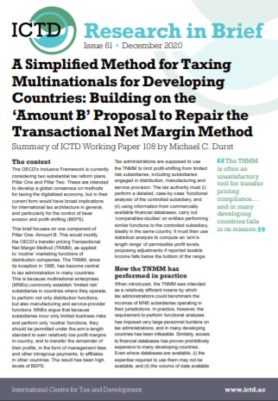Research in Brief 61
The OECD’s Inclusive Framework is currently considering two substantial tax reform plans, Pillar One and Pillar Two. These are intended to develop a global consensus on methods for taxing the digitalised economy, but in their current form would have broad implications for international tax architecture in general, and particularly for the control of base erosion and profit-shifting (BEPS). This brief focuses on one component of Pillar One: Amount B. This would modify the OECD’s transfer pricing Transactional Net Margin Method (TNMM), as applied to ‘routine’ marketing functions of distribution companies. The TNMM, since its inception in 1995, has become central to tax administration in many countries. This is because multinational enterprises (MNEs) commonly establish ‘limited risk’ subsidiaries in countries where they operate, to perform not only distribution functions, but also manufacturing and service-provider functions. MNEs argue that because subsidiaries incur only limited business risks and perform only ‘routine’ functions, they should be permitted under the arm’s-length standard to earn relatively low profit margins in-country, and to transfer the remainder of their profits, in the form of management fees and other intragroup payments, to affiliates in other countries. The result has been high levels of BEPS. Tax administrations are supposed to use the TNMM to limit profit-shifting from limited risk subsidiaries, including subsidiaries engaged in distribution, manufacturing and service provision. The tax authority must (i) perform a detailed, case-by-case ‘functional analysis’ of the controlled subsidiary, and (ii) using information from commercially available financial databases, carry out ‘comparables studies’ on entities performing similar functions to the controlled subsidiary, ideally in the same country. It must then use statistical analysis to compute an ‘arm’s-length range’ of permissible profit levels, proposing adjustments if reported taxable income falls below the bottom of the range. Summary of ICTD Working Paper 108 by Michael C. Durst.
